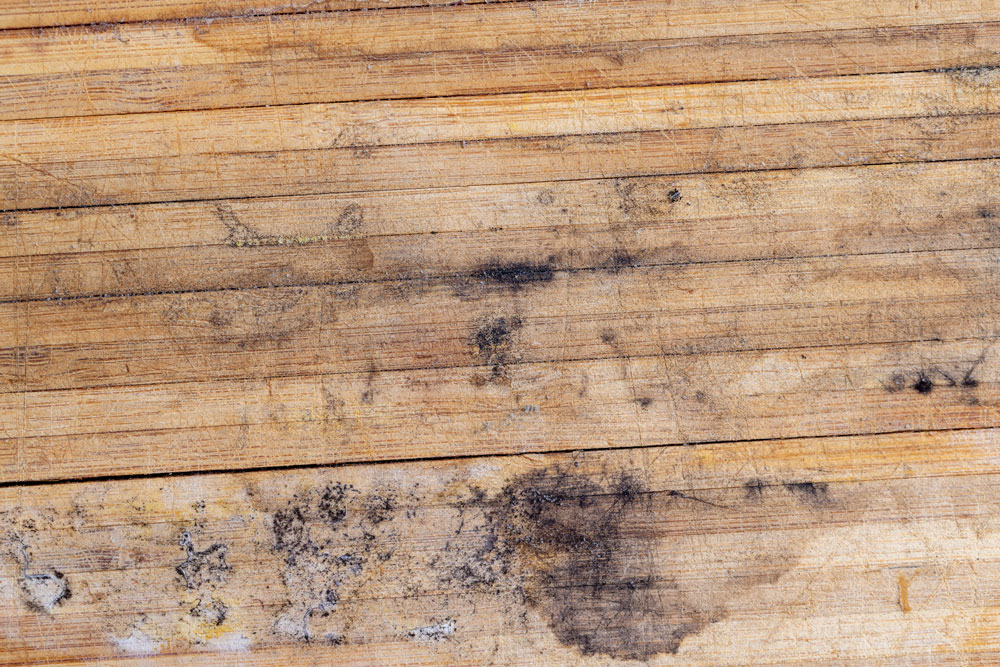How To Remove Mould From Wood
 CONTENTS
CONTENTS
- What causes mould to grow on wood?
- Why must have mould removed from wood
- You must leave mould remediation to professional cleaners
- How to prevent mould growing on wood
- Contact us today
If you have noticed black, green, and white spots or discolouration on the wood in your property, mould is probably growing on it. These marks are not just unsightly, they can put your health at risk and even damage the integrity of the wood.
Here at ICE Cleaning, we offer quick and thorough mould remediation services. Our Dewpoint-accredited technicians can remove all the mould from the surfaces and the air in your property so you can be sure it is completely mould-free.
Read on to find out how to get rid of mould growing on wood.
What causes mould to grow on wood?
Mould is a type of fungus that breaks down dead organic material, like wood. It is caused by excess moisture and is usually triggered by:
- Condensation on windowsills and other surfaces
- High humidity
- Leaks in your home
- Damp
- Poor ventilation
Wood is especially susceptible to mould growth as it is a porous surface so the mould can grow deep in its nooks and crannies. It also contains lots of nutrients and a high sugar content that the mould can feed off. Bare wood absorbs plenty of water, too, so it can stay damp for a long time.
There are a few specific reasons why mould usually starts growing on wooden furniture, flooring, and building materials:
- Your furniture has been in storage for a while and is damp and cold
- Pets with wet fur have been sitting on furniture
- Food and drink have been spilt on your furniture or on the floor
- Condensation has formed on furniture
- Wet coats, shoes, and other possessions have been stored in or on wooden furniture, like wardrobes
There are three different types of mould that normally grow on wood: black, green, and white mould. The moment you spot any mould, you must bring in professional cleaners as soon as possible to have it removed.
Why must have mould removed from wood
Mould is dangerous to your health
Mould produces allergens, irritants, and sometimes toxins. Inhaling, touching, and ingesting mould spores can cause an allergic reaction, such as sneezing, coughing, and eye or skin irritation. People with asthma may also experience asthma attacks.
Some groups are more sensitive to the effects of mould exposure, like young children and babies, elderly people, and people with respiratory and skin problems. You can find out more about how mould could affect your health here.
It can damage wood
Mould eats away at organic materials so it will ultimately destroy the wood. If mould is growing on wooden building materials, this can cause structural damage to your property. Should it grow on your furniture, it could break when someone uses it, putting them at risk of injury.
You must leave mould remediation to professional cleaners
Firstly, they will have the personal protective equipment (PPE) to safely clean the mould without endangering their health.
Cleaners will also have specialist cleaning products and equipment to effectively tackle all the spores. Most DIY solutions and cleaning products cannot kill all the mould and just get rid of the surface spores so it returns soon after treatment.
Mould is particularly tough to remove from wood as it can sink deep into its pores, making it difficult to reach and treat. Specialist cleaners will know the best ways to remove mould from wood so they can eliminate all the spores without damaging the surface.
Our technicians have experience successfully removing mould from a range of surfaces, including wood, and can clean even the most delicate pieces of furniture.
How to prevent mould growing on wood
There are plenty of ways to stop mould growing, from keeping humidity levels below 50% with dehumidifiers, to keeping your property well ventilated. But there are some specific things you can do to keep the wood in your home mould-free.
- Clean the wood in your property regularly
- Have mould removed as soon as you spot it so it does not spread
- Check furniture and flooring regularly for new mould growth
- Move furniture away from outside walls which tend to be colder and can get condensation on them
- Don’t keep wooden furniture in the kitchen and bathroom
- Dry wood as soon as it gets wet so it does not stay damp for too long
Contact us today
Our technicians can diagnose the root cause of the mould and advise on how to stop it coming back. Each of our mould removal services also comes with a lifetime guarantee* so you can be sure your home will stay safe in the future.
Get in touch with our friendly team on 0208 066 0360 or enquiries@icecleaning.co.uk to book our technicians for mould remediation.
*subject to advisories

Speak with me today,
I’m here to help
By asking you a few questions either via phone or email I can immediately provide a realistic estimation of the cost.
You’re in good company. We’ve cleaned for the following commercial clients… View all

Why choose us?
- Cater to a wide variety of cleaning situations
- Nationwide coverage, available 24/7
- Cater to commercial and domestic clients
- Free survey provided prior to quotation
- Emergency response team
- Offer a bespoke service designed to suit all your needs
- All technicians hold professional health and safety qualifications, including BICSc, IOSH, Dewpoint Professional & Safe Contractor
We’re fully accredited
We place best practise, professional expertise and health and safety at the core of our business. We’re fully compliant with all legal obligations. You can view a list of our accreditations below, or visit our Health & Safety page for more information.











-RGB-small.1707319151.jpg)




















